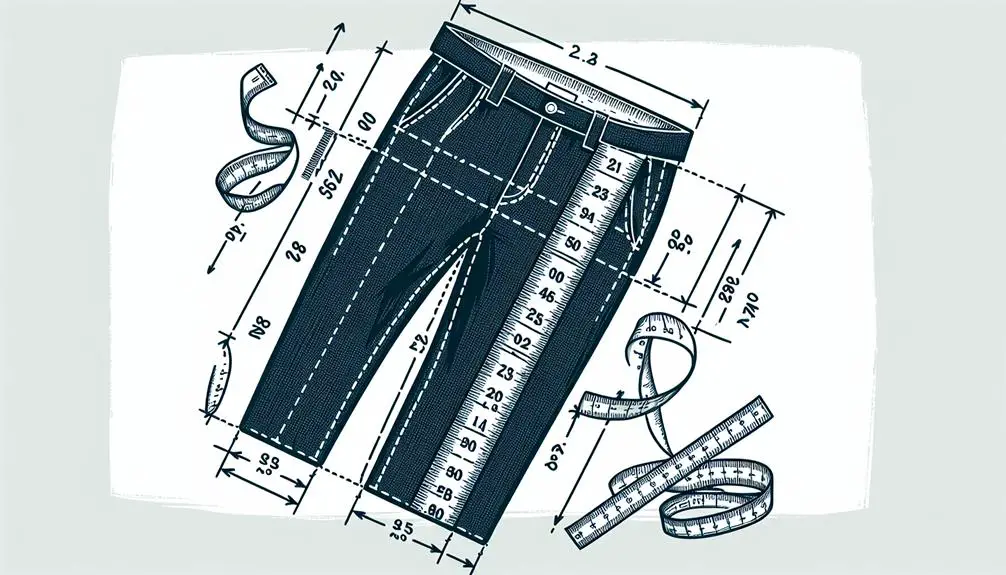When I was younger, I once bought a pair of pants online based solely on the outseam measurement, thinking it would fit perfectly. To my dismay, when they arrived, the inseam was too short, and the waistband sat awkwardly high.
Understanding the outseam to inseam conversion is like navigating a map; each measurement is a different landmark guiding you to the perfect fit. Let's unravel the mystery behind these measurements and discover how mastering this conversion can save us from fashion mishaps and ensure our pants fit like a glove.
Table of Contents
Key Takeaways
- Outseam helps determine overall length while inseam focuses on crotch to hem distance.
- Subtracting rise from outseam gives accurate inseam measurement for tailoring.
- Understanding outseam to inseam conversion ensures custom fit and style preferences.
- Proper outseam and inseam measurements are essential for flattering pant lengths and fit.
Importance of Outseam and Inseam
Understanding the importance of outseam and inseam is crucial for achieving the perfect fit when it comes to selecting the right pair of pants. Based on personal experience, I've found that the outseam and inseam measurements play a significant role in how well trousers fit.
While outseam measures the overall length from the waist to the hem, inseam focuses on the distance from the crotch to the hem. This distinction is vital because it offers different perspectives on pant length. I've noticed that inseam tends to be a more reliable measurement for consistent sizing based on body proportions, ensuring a better overall fit.
In contrast, outseam can vary due to factors like the waistband placement and style of the pants. By focusing on waist and inseam measurements, I've been able to select pants that fit well in various areas such as the hips, seat, thighs, and lower leg, ultimately enhancing both comfort and style.
Measuring Outseam Correctly
When it comes to measuring outseam correctly, I always start at the waistband and run the tape measure down to the hem of the pants for accuracy. Using the right tools for measuring ensures that the outseam length is precise and reflects how the pants will fit.
Mastering proper outseam measurement is key to understanding how the waistband placement influences the overall length and style of the pants.
Proper Outseam Measurement
To accurately measure the outseam of pants, start from the waistband and extend the flexible measuring tape down to the desired hem length, following the natural curve of your body. Make sure the measuring tape hangs straight down without being pulled tight for consistent results. When determining the outseam measurement for tailored or custom pants, consider the desired fit and style. Always double-check your measurement to ensure the correct length before altering or purchasing pants.
| Step | Instructions | Importance |
|---|---|---|
| 1. Start Point | Begin at the waistband | Ensures measurement starts at the right place |
| 2. Direction | Extend tape down following natural body curve | Captures accurate length based on body shape |
| 3. End Point | Stop at the desired hem length | Determines the final length of the pants |
Tools for Measuring
After mastering the proper outseam measurement technique, the next step is ensuring you have the right tools for accurately measuring the outseam of your pants. A flexible measuring tape is essential for obtaining precise outseam measurements. Make sure the pants are flat and smooth before starting the measurement from the top of the waistband to the bottom of the pant leg.
Double-check your measurement to guarantee accuracy before comparing it to inseam measurements. Knowing the outseam measurement is crucial for determining the overall length and fit of your pants. With the correct tools and technique, you can confidently measure the outseam of your pants for a perfect fit every time.
Understanding Inseam Measurements
Understanding inseam measurements is essential for getting the right fit in pants.
It's all about knowing the basics of inseam measurement, finding the correct inseam for your body, and understanding why inseam length matters.
This knowledge will help you achieve a well-tailored and polished look whenever you put on a pair of pants.
Inseam Measurement Basics
Inseam measurements provide a crucial yardstick for determining the proper length and fit of pants. Understanding the basics of inseam measurements is key to achieving a well-tailored look.
- Inseam measures the length from the crotch to the hem, ensuring a consistent pants length.
- It plays a vital role in determining the right fit based on individual body proportions.
- Different pant styles and cuts can affect inseam length, impacting overall comfort and appearance.
- Knowing your inseam measurement helps in selecting pants that require minimal alterations.
- Mastering inseam measurements is fundamental for achieving a polished and comfortable fit in trousers.
Finding Correct Inseam
Transitioning from grasping the basics of inseam measurements, let's now focus on uncovering the key to finding the correct inseam for your pants to achieve the perfect fit.
The inseam measurement is vital as it determines the length of pants from the crotch to the hem, providing a consistent reference for fitting based on individual body proportions. Understanding your inseam helps anticipate how the pants will fall on your legs.
Although inseam lengths are somewhat standardized across brands and styles, ensuring the correct inseam measurement is crucial to avoiding pants that are either too short or too long. By mastering the correct inseam measurement, you can guarantee a tailored and comfortable fit every time you put on a pair of pants.
Importance of Inseam
Exploring the significance of inseam measurements reveals a fundamental aspect in achieving a well-fitted pair of pants. Understanding inseam measurements is vital for ensuring the perfect length and fit. Here are some key points to consider:
- Inseam measurement determines the length of pants from the crotch to the hem.
- It provides a more accurate assessment of how pants will fit based on body proportions.
- Inseam length is consistent across various brands and styles, ensuring uniformity.
- Knowing your inseam measurement helps avoid issues like pants being too short or too long.
- Mastering inseam measurements is essential for selecting the right pant length and achieving a polished look.
Converting Outseam to Inseam
Subtracting the rise measurement from the outseam length is the key step in converting outseam to inseam for determining the proper length of pants. The rise measurement, which indicates the distance from the crotch seam to the top of the waistband, plays a crucial role in this conversion process. By subtracting the rise measurement from the outseam, you arrive at the inseam measurement, which is essential for achieving a well-fitted pair of pants.
Understanding how to convert outseam to inseam is vital, especially when tailoring or altering pants to ensure a customized fit. This conversion method not only helps in determining the right length of pants but also contributes to overall comfort and style. By mastering this conversion technique, you can confidently adjust the length of pants to suit your preferences and body shape, enhancing your overall appearance and comfort.
Whether you're a tailor, seamstress, or simply someone looking to alter their pants, knowing how to convert outseam to inseam is a valuable skill to have.
Tips for Perfect Pant Length
To ensure the perfect pant length, consider these practical tips that can elevate your style and comfort effortlessly.
- Know Your Inseam Measurement: Measure from the crotch to the bottom of your leg for the most accurate inseam length.
- Consider Your Shoe Choices: Different pant lengths work better with various shoe styles, so keep this in mind when deciding on the perfect length.
- Tailor for the Perfect Fit: If off-the-rack pants don't fit perfectly, consider getting them hemmed for a custom look.
- Pay Attention to Pant Breaks: Decide whether you prefer a full break, half break, or no break at all, as this affects the overall appearance of the pants.
- Test Different Lengths: Try on different lengths to see what flatters your body shape the most and gives you the look you desire.
Outseam-Inseam Ratio Considerations
Considering the style and fit of trousers, understanding the outseam to inseam ratio is crucial for achieving the perfect length and overall look.
The outseam to inseam ratio can vary significantly depending on the style and fit of the pants. For standard trousers, the outseam is typically 1.5-2 times the inseam measurement. However, slim fit or high-rise trousers may have a lower ratio, around 1.2-1.5 times, while wide-leg or low-rise trousers could have a higher ratio, like 2-2.5 times.
Being aware of this ratio is essential as it can greatly impact the overall length and style of the pants, ensuring a better fit and aesthetic. By understanding how the outseam and inseam measurements correlate, you can make more informed decisions when selecting and altering trousers, ultimately enhancing your style and comfort.
Common Outseam to Inseam Mistakes
Making a mistake when confusing outseam and inseam measurements can lead to poorly fitting pants that detract from your overall style and comfort. It's crucial to understand the differences between these measurements to ensure your trousers fit just right.
Here are some common outseam to inseam mistakes to avoid:
- Relying solely on outseam: Outseam length can vary based on the rise of the pants, leading to inconsistencies in fit.
- Neglecting inseam measurement: Inseam is a more reliable indicator of how long your pants should be, so mistaking it for outseam can result in pants that are too short or too long.
- Overlooking the importance of accuracy: Proper pant sizing requires precise outseam and inseam measurements to achieve a tailored look.
- Ignoring the fit implications: Mixing up outseam and inseam can affect how the pants sit on your body, impacting both comfort and style.
- Skipping the measurement step: Taking the time to accurately measure both outseam and inseam ensures a better fit and enhances your overall appearance.
Frequently Asked Questions
Can You Calculate Inseam From Outseam?
I can't accurately calculate inseam from outseam due to rise and waistband variations. Outseam measurement reflects rise height and body proportions. Inseam is more reliable for pant length. Focus on inseam for proper fit.
How Long Should My Outseam Be?
For the right outseam length, consider your rise and desired style. Classic trousers hit the ankle bone, while modern cuts can end above it. Personal preference matters. Ensure the pants balance your proportions for a flattering fit.
What Does 20 Inch Outseam Mean?
A 20-inch outseam means a shorter pant or short length, often suited for a cropped look. It's great for those with shorter legs or seeking a casual vibe. This measurement helps in selecting the right style and fit.
What Is the Relationship Between Inseam and Outseam?
Understanding the relationship between inseam and outseam is key in determining the fit and style of pants. Inseam measures the length from crotch to hem, while outseam measures waistband to hem. Each provides unique insights into pant design.
- Tetron Fabric for Medical Textiles: Hygiene and Safety Standards - June 18, 2025
- Tetron Fabric for Outdoor Gear: Durability and Weather Resistance - June 17, 2025
- Tetron Fabric for Sportswear: Performance and Comfort - June 17, 2025





